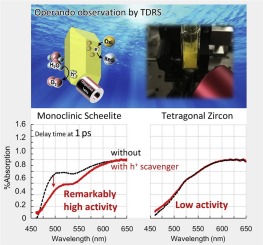Journal of Photochemistry and Photobiology A: Chemistry ( IF 4.1 ) Pub Date : 2020-03-20 , DOI: 10.1016/j.jphotochem.2020.112493 Ryo Miyasato , Masazumi Fujiwara , Chiasa Uragami , Haruyuki Sato , Toshihiro Yano , Hideki Hashimoto

|
Photocatalytic water splitting has been believed to be a key technology for the construction of a sustainable society based on a renewable energy source. Understanding the exact mechanisms of oxygen evolution by water-splitting reaction, which has been regarded as a bottleneck to realize the water splitting in practical basis, should help us to enhance solar-to-hydrogen energy conversion efficiency. Here, we present a detailed investigation based on two types of bismuth vanadate (BiVO4) crystals. One is a monoclinic scheelite crystal that forms a truncated tetragonal bipyramidal shape (MS), and the other is a tetragonal zircon crystal that forms an octahedral shape (TZ). MS, which has relatively higher photocatalytic activity of water oxidation, rarely adsorbed reduced mediator (Fe2+). Operando time-resolved diffuse reflection spectral measurement demonstrated, for the first time, that the surface holes of MS crystals show extremely high reactivity, while those of TZ crystals show poor reactivity. Our investigation would promote an essential understanding of the photocatalytic reaction mechanism of water oxidation.
中文翻译:

Operando时间分辨漫反射光谱:钒酸铋的光催化水氧化活性的起源
人们认为光催化水分解是构建基于可再生能源的可持续社会的关键技术。理解水分解反应产生氧气的确切机理(在实践中被视为实现水分解的瓶颈),将有助于我们提高太阳能到氢能的转化效率。在这里,我们提出基于两种类型的钒酸铋(BiVO 4)晶体的详细研究。一种是单斜白钨矿晶体,形成截顶的四边形双锥体形状(MS),另一种是形成八面体形状(TZ)的四方锆石晶体。多发性硬化症,具有较高的水氧化光催化活性,很少吸附还原性介质(Fe 2+)。Operando时间分辨的漫反射光谱测量首次证明,MS晶体的表面空穴显示出极高的反应性,而TZ晶体的表面空穴显示出不良的反应性。我们的研究将促进对水氧化的光催化反应机理的基本了解。











































 京公网安备 11010802027423号
京公网安备 11010802027423号